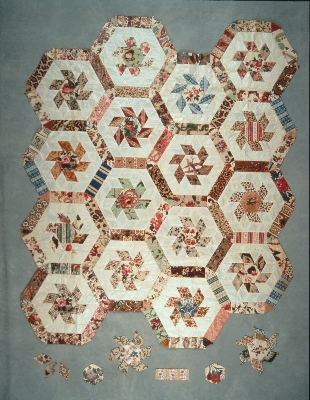Quilt No.766PHM - Powerhouse Museum

Owner:
Powerhouse Museum
Location:
NSW Sydney
Maker
Maker:
Unknown
Made in
ENGLAND
Patterms
Date:
pre 1850
Description:
"An unfinished quilt in traditional 'Pinwheel' pattern, handsewn with linen thread using the English method. The quilt is composed of sixteen large hexagonal blocks made up of square, diamond and triangular patches around a central hexagon. The central motifs and outer borders are of block printed floral and geometric patterned glazed cotton chintz, with plain white cotton chintz as the background. The patches still have their original paper templates in place; many of these are covered with handwritten numbers and are perhaps from a school exercise book. A collection of templates,...
History:
"The quilt was given to the museum in 1987 by Mr and Mrs N D Cook of Bowral, NSW. The grandparents of both Mr and Mrs Cook came to Australia from England, and they are not sure which side of the family brought the quilt here with them." [PHM]
Story:
"The fabrics from which the quilt was made are of different dates, the earliest probably dating to the late 1700s, and were probably collected over several years. They are in new condition which suggests the maker was well to do and patchwork a pleasant way to pass the time rather than an economic necessity. The quilt was probably made in England around 1840 and brought to Australia some time after that." [PHM]
Related Quilts:
Crazy patchqork quilt, handsewn, composed of six large squares of patches in brocade, velvet and silk in random shapes and sizes. Patches are stitched to others by blanket stitch in yellow thread. Some patches have surface embroidery, e.g. a dragonfly, flowers, music notes, and names, 'Minnie', 'Loyetta' (house in Ballarat), 'Diana'. There are also five small cream bobbles. Colours are red, gold, brown, pinks, greens and blues. Padding is flannel, and quilt is backed and edged with maroon or burgundy ribbed silk.
1461mm x 687mm
1461mm x 687mm
Double sided quilt made from woollen suiting pieces some of which have hand worked eyelets. Many of the rectangles are irregular. Both sides use similar pieces but arranged in different patterns. There is no padding.
2160 x 1524mm
2160 x 1524mm
Patchwork top made of cottons, constructed with 5 by 5 rows of squared 8 point pieced stars alternating with white cross-shaped blocks (made from 4 pieces). On all sides are borders of half stars. The outer border is of rectangles of cotton prints appliquéd on to cotton to form a plaited pattern. The border only is backed with a band of cream cotton. All patches are whip stitched together.
2645 x 2615mm
2645 x 2615mm
Medallion style all cotton quilt made in the USA. Hand pieced with centre panel of 'cheater' material pre printed in a patchwork design. Bordered with 'Nine Patch' and sashing. The backing is printed cotton and the padding is cotton. The quilt has yellow tufting or ties in wool.
1855 x 1525mm
1855 x 1525mm
Patchwork quilt made from squares and rectangles of pink, blue and white fabric set with a frame of pink and white print around a centre rectangle made of 4 pink triangles. Four corner squares of blue and white stripes, Many squares are pieced from smaller scraps. The Material is a crepe type, possibly used for underwear. Handsewn and machined. Backing is made from cotton scraps, possibly lawn or similar. Padding is flanellete or similar. Edges are bound in a striped material. Quilt shows signs of wear.
620mm x 520mm
620mm x 520mm
Repeat block in Dresden Plate pattern using various cotton fabrics from the 1920s. Quilted with a flower in the purple/pink centre and squares elsewhere. Border is furnishing fabric. The padding is cotton that is disintegrating and the backing is calico. 1980 x 2100mm






